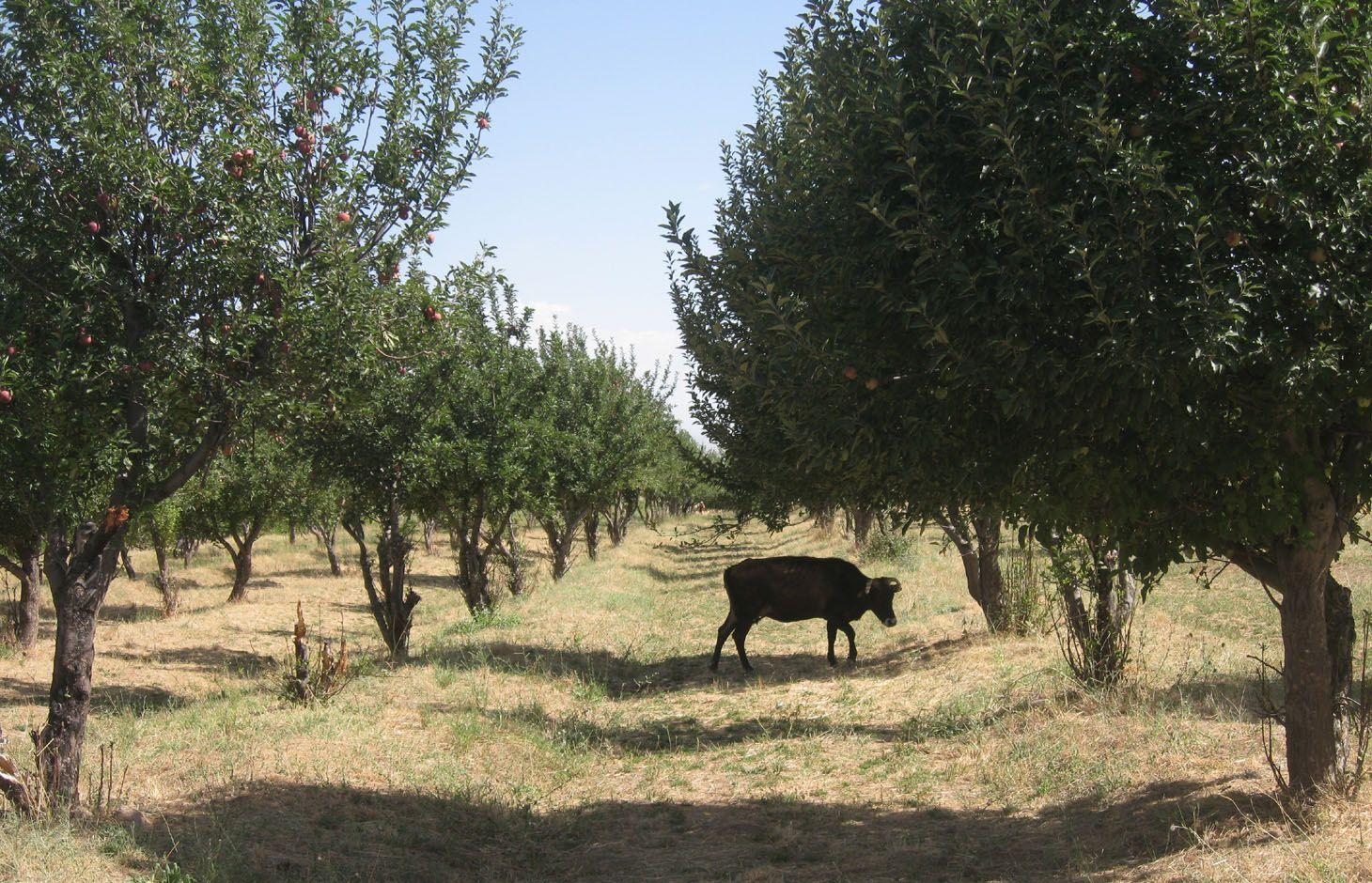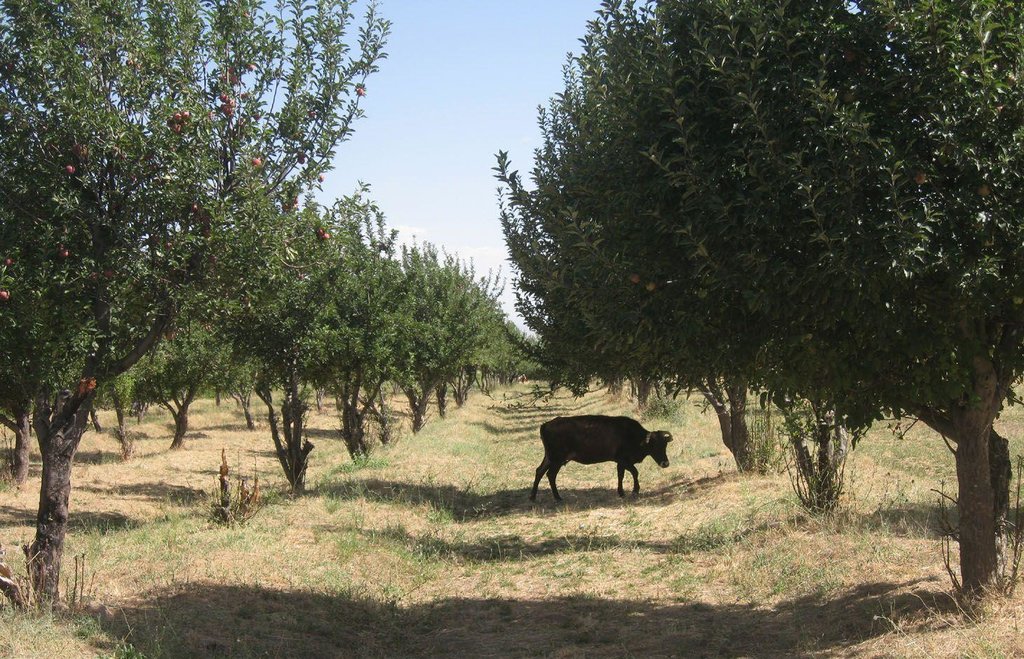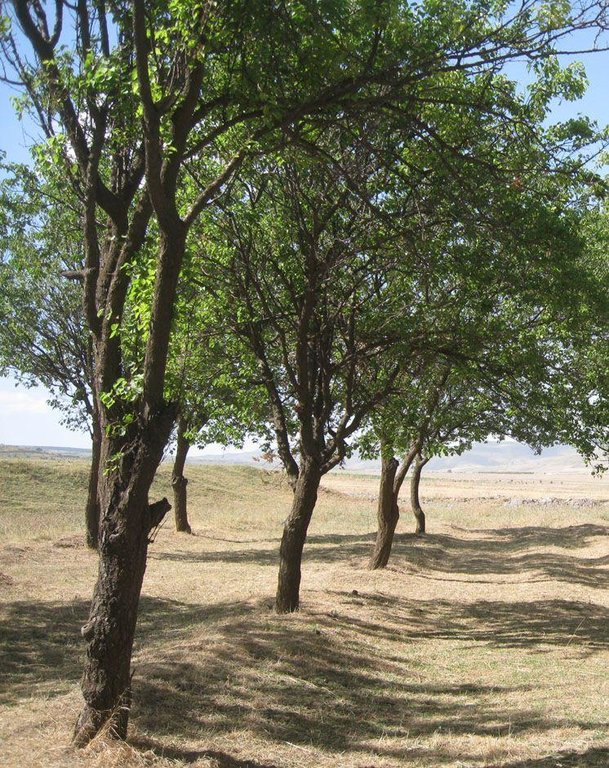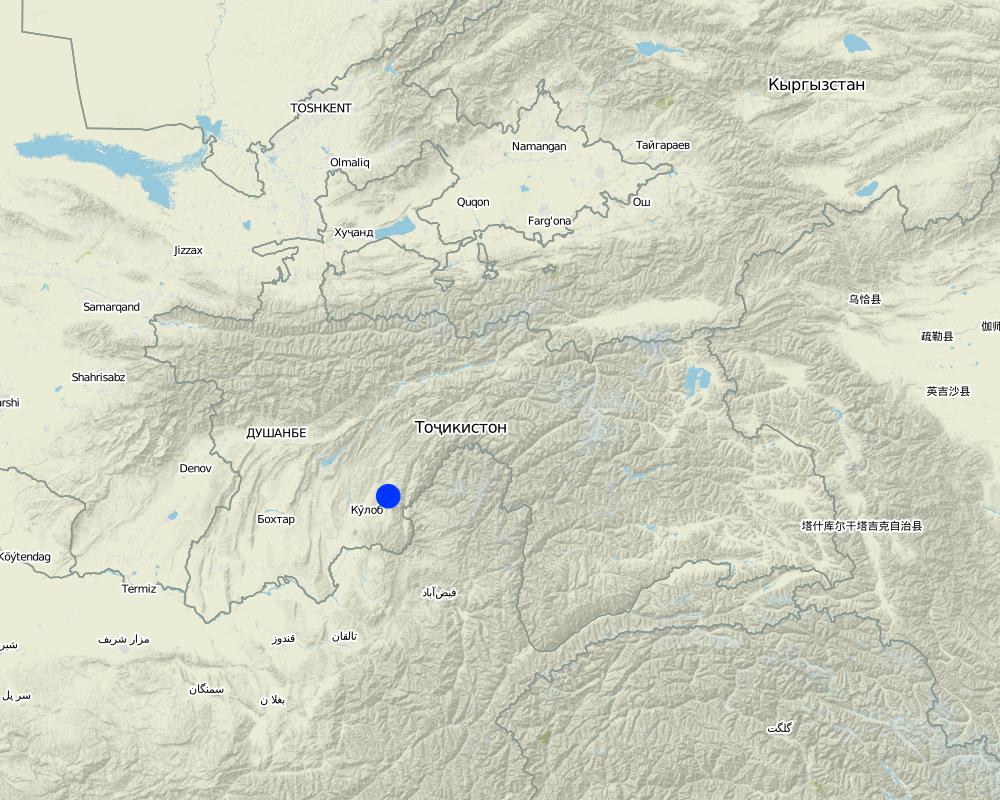Current agroforesty of an apple orchard with wheat cropping [Tajikistan]
- Creation:
- Update:
- Compiler: Malgorzata Conder
- Editor: –
- Reviewers: Fabian Ottiger, Alexandra Gavilano
technologies_1172 - Tajikistan
View sections
Expand all Collapse all1. General information
1.2 Contact details of resource persons and institutions involved in the assessment and documentation of the Technology
Name of the institution(s) which facilitated the documentation/ evaluation of the Technology (if relevant)
CDE Centre for Development and Environment (CDE Centre for Development and Environment) - Switzerland1.3 Conditions regarding the use of data documented through WOCAT
The compiler and key resource person(s) accept the conditions regarding the use of data documented through WOCAT:
Yes
2. Description of the SLM Technology
2.1 Short description of the Technology
Definition of the Technology:
Agroforestry of an old apple orchard with wheat cropping
2.2 Detailed description of the Technology
Description:
The farmer grows red, yellow and white apples in his orchard of 3.75 ha. Wheat is growing in the slightly pronounced terraces and recently some vines were planted this year. The rain fed orchard lies in the low part of the middle zone and has a slight slope. The absence of control and fence results in broken branches and trampled parts in the plot. The farmer is sharing the property with his four brothers, who inherited the property from their father in 1993 or 1994. The orchard was established during Soviet time in 1988. The government paid for the material and the farmer’s family did the labour. The government paid them for that input by crop yield. In addition to the orchard the farmer sewed wheat between the rows several years ago which adds up to a hectare of wheat crop in total. In the current year (2012), the workload and the yield have been very small. As there was heavy rainfall in spring, the farmer did not see the need to loose soil around the trees. The already old fruit trees gave low yield and, because of a hale storm, apples were destroyed.
Purpose of the Technology: Initially the government planned to manage land and make it more profitable by establishing orchards. Due to that intention the farmer’s family had work, subsistent crop and cash crops. Today the main source of income is the remittances from the sons who work in Russia. The farmer works part time as a taxi driver. The orchard lost its importance of main income.
Establishment / maintenance activities and inputs: At the time of the establishment of the fruit trees, the Soviet government paid for the seedlings and tractor fuel. Labour was done by the farmer, his brothers and their parents. The whole family worked for two years to build the orchard because they only had the possibility to work in the evenings and on weekends. Nowadays it is still a part time job for the farmer. Maintenance activities consist of ploughing, occasional soil loosening around the trees, pruning and harvesting apples and wheat. The wheat is cut by hand, which is very hard work. Because of heavy rainfalls last spring no soil was loosened. There is nobody to protect the orchard from grazing livestock.
Natural / human environment: The orchard lies on a foothill in the middle zone, close to the settlements of the valley. The apples trees are growing in rows on small terraces built by ploughing for years. Down- and upwards there are also orchards growing, all delimited laterally by the riverbed and a road. On one side of the plot a gully is developing rapidly. All of the neighbouring orchards seem to have a lack of maintenance and control. The orchards lying above but not far away from the settlements are accessible by car and tractor.
2.3 Photos of the Technology
2.5 Country/ region/ locations where the Technology has been applied and which are covered by this assessment
Country:
Tajikistan
Region/ State/ Province:
Khatlon, Tajikistan
Further specification of location:
Muminabad
Specify the spread of the Technology:
- evenly spread over an area
If precise area is not known, indicate approximate area covered:
- < 0.1 km2 (10 ha)
Comments:
Total area covered by the SLM Technology is 3.75 km2.
Property belongs to five sons
Map
×2.6 Date of implementation
If precise year is not known, indicate approximate date:
- 10-50 years ago
2.7 Introduction of the Technology
Specify how the Technology was introduced:
- through projects/ external interventions
Comments (type of project, etc.):
in 1988 orchard was established, since 1993 or 1994 the orchard belongs to the farmer and his four brothers
3. Classification of the SLM Technology
3.1 Main purpose(s) of the Technology
- improve production
- reduce, prevent, restore land degradation
3.2 Current land use type(s) where the Technology is applied
Land use mixed within the same land unit:
Yes
Specify mixed land use (crops/ grazing/ trees):
- Agroforestry

Cropland
- Annual cropping
- Tree and shrub cropping
Annual cropping - Specify crops:
- cereals - wheat (spring)
Tree and shrub cropping - Specify crops:
- fruits, other
- pome fruits (apples, pears, quinces, etc.)
Number of growing seasons per year:
- 1
Specify:
Longest growing period in days: 180 Longest growing period from month to month: March to September

Grazing land

Forest/ woodlands
Comments:
Major land use problems (compiler’s opinion): Low soil nutrients and moisture
A lot of bare, compacted and trampled soil which impedes a high infiltration rate
Not sufficiently maintained orchard, incorrectly prouned fruit trees
Deep rill through the middle of the plot
Major land use problems (land users’ perception): Soil is leached out
Fruit trees are old and hence don't give a high yield
Water is only seasonally available
Low infiltration
Livestock is grazing on crop residues
3.4 Water supply
Water supply for the land on which the Technology is applied:
- rainfed
3.5 SLM group to which the Technology belongs
- agroforestry
3.6 SLM measures comprising the Technology

agronomic measures
- A1: Vegetation/ soil cover

vegetative measures
- V1: Tree and shrub cover
Comments:
Type of agronomic measures: mixed cropping / intercropping, contour tillage
3.7 Main types of land degradation addressed by the Technology

soil erosion by water
- Wg: gully erosion/ gullying
- Wo: offsite degradation effects

chemical soil deterioration
- Cn: fertility decline and reduced organic matter content (not caused by erosion)

physical soil deterioration
- Pc: compaction

biological degradation
- Bc: reduction of vegetation cover
Comments:
Main type of degradation addressed: Pc: compaction, Bc: reduction of vegetation cover
Secondary types of degradation addressed: Wg: gully erosion / gullying, Wo: offsite degradation effects, Cn: fertility decline and reduced organic matter content
Main causes of degradation: soil management, crop management (annual, perennial, tree/shrub)
Secondary causes of degradation: overgrazing, Heavy / extreme rainfall (intensity/amounts) (low infiltration rate and heava rainfalls cause rill formation)
4. Technical specifications, implementation activities, inputs, and costs
4.1 Technical drawing of the Technology
Technical specifications (related to technical drawing):
The rows with the apple trees are not contour lined, reason why the plot counts 11 rows from one and 13 rows from the other side. The fruit trees grow with a distance of 6 metres to each other. Up to 30 trees were in a row, but due to drying or cutting out (shown in the drawing as "no trees") there are currently some 20 to 25 trees per row in average. Wheat is growing between the rows, mechanical plowing built some terrace-like relief as seen in the profile and sequency "A". A rill dominates the orchard where run off is drained.
Location: Chukurak watershed. Muminabad, Khatlon, Tajikistan
Technical knowledge required for field staff / advisors: high
Technical knowledge required for land users: high
Mixed cropping / intercropping
Material/ species: wheat intercropped in an orchard
Author:
Conder Malgorzata
4.2 General information regarding the calculation of inputs and costs
other/ national currency (specify):
Somoni
If relevant, indicate exchange rate from USD to local currency (e.g. 1 USD = 79.9 Brazilian Real): 1 USD =:
4.83
Indicate average wage cost of hired labour per day:
12.40
4.3 Establishment activities
| Activity | Timing (season) | |
|---|---|---|
| 1. | Buying, transporting and planting trees (5 TJS and 20 min for plantin per tree) | once, spring, in 1988 |
4.4 Costs and inputs needed for establishment
| Specify input | Unit | Quantity | Costs per Unit | Total costs per input | % of costs borne by land users | |
|---|---|---|---|---|---|---|
| Labour | Buying, transporting and planting tree | person days | 50.0 | 12.422 | 621.1 | 100.0 |
| Equipment | Machine use | Days | 1.0 | 16.6 | 16.6 | |
| Plant material | Seedlings | Seedlings | 1200.0 | 1.03516666 | 1242.2 | |
| Total costs for establishment of the Technology | 1879.9 | |||||
| Total costs for establishment of the Technology in USD | 389.21 | |||||
Comments:
Duration of establishment phase: 24 month(s)
4.5 Maintenance/ recurrent activities
| Activity | Timing/ frequency | |
|---|---|---|
| 1. | Plowing, 6 hours, 1 person | spring since 1988 |
| 2. | Sowing, 3 hours, 1 person | once a year |
| 3. | Cutting wheat manually by, 1 week (7h/day) 6 pers | once a year, autumn |
| 4. | Soil loosening (it was not done in 2012) | once a year, spring |
| 5. | Pruning (it was not done in 2012) | every tree once in 3 years |
| 6. | Harvesting apples (1000) | once a year, autumn |
4.6 Costs and inputs needed for maintenance/ recurrent activities (per year)
| Specify input | Unit | Quantity | Costs per Unit | Total costs per input | % of costs borne by land users | |
|---|---|---|---|---|---|---|
| Labour | Plowing | Person days | 0.75 | 12.4 | 9.3 | 100.0 |
| Labour | Sowing | Person days | 0.375 | 12.4 | 4.65 | 100.0 |
| Labour | Cutting wheat manually | Person days | 36.75 | 12.4 | 455.7 | 100.0 |
| Labour | Soil loosening | Trees | 1000.0 | 0.1941 | 194.1 | 100.0 |
| Equipment | Petrol | liters | 40.0 | 1.1375 | 45.5 | 100.0 |
| Equipment | Machine use | Hours | 3.0 | 6.9 | 20.7 | 100.0 |
| Plant material | Seeds | Kg | 200.0 | 0.414 | 82.8 | 100.0 |
| Other | Pruning | Trees | 400.0 | 0.711 | 284.4 | 100.0 |
| Other | Harvesting apples | Apples | 1000.0 | 0.7453 | 745.3 | 100.0 |
| Total costs for maintenance of the Technology | 1842.45 | |||||
| Total costs for maintenance of the Technology in USD | 381.46 | |||||
Comments:
Establishment phase: Seedlings and transport were paid by the government, planting was done by the farmer and his family. Labor (recurrent activity(3))for apple harvesting calculated according to T_TAJ013.
4.7 Most important factors affecting the costs
Describe the most determinate factors affecting the costs:
Labour affects the cost the most, secondly the seedlings (which were subsidised).
5. Natural and human environment
5.1 Climate
Annual rainfall
- < 250 mm
- 251-500 mm
- 501-750 mm
- 751-1,000 mm
- 1,001-1,500 mm
- 1,501-2,000 mm
- 2,001-3,000 mm
- 3,001-4,000 mm
- > 4,000 mm
Specifications/ comments on rainfall:
Totally 800 mm: 700mm in winter-spring, July-Sept dry season
Agro-climatic zone
- sub-humid
Thermal climate class: temperate, LPG from end of March until September
5.2 Topography
Slopes on average:
- flat (0-2%)
- gentle (3-5%)
- moderate (6-10%)
- rolling (11-15%)
- hilly (16-30%)
- steep (31-60%)
- very steep (>60%)
Landforms:
- plateau/plains
- ridges
- mountain slopes
- hill slopes
- footslopes
- valley floors
Altitudinal zone:
- 0-100 m a.s.l.
- 101-500 m a.s.l.
- 501-1,000 m a.s.l.
- 1,001-1,500 m a.s.l.
- 1,501-2,000 m a.s.l.
- 2,001-2,500 m a.s.l.
- 2,501-3,000 m a.s.l.
- 3,001-4,000 m a.s.l.
- > 4,000 m a.s.l.
5.3 Soils
Soil depth on average:
- very shallow (0-20 cm)
- shallow (21-50 cm)
- moderately deep (51-80 cm)
- deep (81-120 cm)
- very deep (> 120 cm)
Soil texture (topsoil):
- medium (loamy, silty)
- fine/ heavy (clay)
If available, attach full soil description or specify the available information, e.g. soil type, soil PH/ acidity, Cation Exchange Capacity, nitrogen, salinity etc.
Soil fertility: Low
Soil drainage/infiltration: Poor
Soil water storage capacity: Low
5.4 Water availability and quality
Availability of surface water:
poor/ none
Water quality (untreated):
for agricultural use only (irrigation)
5.5 Biodiversity
Species diversity:
- low
5.6 Characteristics of land users applying the Technology
Market orientation of production system:
- subsistence (self-supply)
Off-farm income:
- > 50% of all income
Relative level of wealth:
- average
Individuals or groups:
- individual/ household
Level of mechanization:
- manual work
- mechanized/ motorized
Gender:
- men
Indicate other relevant characteristics of the land users:
Land users applying the Technology are mainly common / average land users
Population density: 100-200 persons/km2
Annual population growth: 1% - 2%
Off-farm income specification: The farmer is working mainly as taxi driver
Level of mechanization: Manual labour (ranked 1, sowing, harvesting, soil losening) and mechanised (ranked 2, plowing)
5.7 Average area of land used by land users applying the Technology
- < 0.5 ha
- 0.5-1 ha
- 1-2 ha
- 2-5 ha
- 5-15 ha
- 15-50 ha
- 50-100 ha
- 100-500 ha
- 500-1,000 ha
- 1,000-10,000 ha
- > 10,000 ha
Is this considered small-, medium- or large-scale (referring to local context)?
- small-scale
Comments:
2.06 ha (household 7.7 members)
5.8 Land ownership, land use rights, and water use rights
Land ownership:
- individual, titled
Land use rights:
- leased
Water use rights:
- communal (organized)
5.9 Access to services and infrastructure
health:
- poor
- moderate
- good
education:
- poor
- moderate
- good
technical assistance:
- poor
- moderate
- good
employment (e.g. off-farm):
- poor
- moderate
- good
markets:
- poor
- moderate
- good
energy:
- poor
- moderate
- good
roads and transport:
- poor
- moderate
- good
drinking water and sanitation:
- poor
- moderate
- good
financial services:
- poor
- moderate
- good
6. Impacts and concluding statements
6.1 On-site impacts the Technology has shown
Socio-economic impacts
Production
crop production
Comments/ specify:
middle-term increase however possibility of lower harvest due to lack of maintenance
Income and costs
farm income
Comments/ specify:
not on short-term, low harvest if maintenance is done poorly.
workload
Comments/ specify:
Less mainetnance work
Socio-cultural impacts
food security/ self-sufficiency
Comments/ specify:
low harvest, but it is not the only source of income
Ecological impacts
Water cycle/ runoff
water quantity
Comments/ specify:
Difficult to compare established orchard with szenario without orchard
surface runoff
Soil
soil moisture
soil cover
soil crusting/ sealing
soil compaction
soil organic matter/ below ground C
Climate and disaster risk reduction
wind velocity
6.2 Off-site impacts the Technology has shown
downstream flooding
buffering/ filtering capacity
6.3 Exposure and sensitivity of the Technology to gradual climate change and climate-related extremes/ disasters (as perceived by land users)
Gradual climate change
Gradual climate change
| Season | increase or decrease | How does the Technology cope with it? | |
|---|---|---|---|
| annual temperature | increase | not well |
Climate-related extremes (disasters)
Meteorological disasters
| How does the Technology cope with it? | |
|---|---|
| local rainstorm | not well |
| local windstorm | not known |
Climatological disasters
| How does the Technology cope with it? | |
|---|---|
| drought | not well |
Hydrological disasters
| How does the Technology cope with it? | |
|---|---|
| general (river) flood | not well |
Other climate-related consequences
Other climate-related consequences
| How does the Technology cope with it? | |
|---|---|
| reduced growing period | not well |
6.7 Strengths/ advantages/ opportunities of the Technology
| Strengths/ advantages/ opportunities in the land user’s view |
|---|
|
Increase of productivity of the land by establishing an orchard. How can they be sustained / enhanced? Give more power and knowledge to farmers to raise responsability for the crops. |
| Strengths/ advantages/ opportunities in the compiler’s or other key resource person’s view |
|---|
|
Land management is right if maintenance and technical assistence are warranted. How can they be sustained / enhanced? Support of establishment and recurrent activities is important. |
6.8 Weaknesses/ disadvantages/ risks of the Technology and ways of overcoming them
| Weaknesses/ disadvantages/ risks in the land user’s view | How can they be overcome? |
|---|---|
| Old trees. | Plant new ones. |
| Weaknesses/ disadvantages/ risks in the compiler’s or other key resource person’s view | How can they be overcome? |
|---|---|
| Orchard is not well maintained (sporadical soil loosening, pruning, control). | Knowledge transfer with e.g. demonstration of well maintained orchards and round tables to share farming experiences. |
| Support shoulb not only focus on the establishment phase (by provdiding funds) but also in a long-term providing cultivation knowledge. |
7. References and links
7.1 Methods/ sources of information
Links and modules
Expand all Collapse allLinks
No links
Modules
No modules





